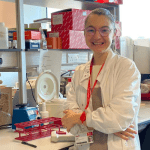PASTE-Mediated Superexon Replacement of COL7A1 as a Treatment for Dystrophic Epidermolysis Bullosa
Lay summary
Over the last 30 years we have learned that dystrophic epidermolysis bullosa (DEB) is caused by DNA variants in the type VII collagen gene (COL7A1). Without a functional COL7A1 gene, the skin cannot make enough type VII collagen protein which means that the skin is less resilient to injury and blisters develop.
The challenge for researchers has been how to replace or fix the COL7A1 gene. Listening to people with DEB, we know that the dream of a “gene cream” is high on everyone’s wish list. We are also excited by recent progress in developing a new topical COL7A1 gene product by colleagues in Stanford University in partnership with Krystal Biotech, although that approach needs to have repeated applications to have a long-lasting effect.
Our new research project is about developing a permanent form of topical COL7A1 gene therapy. At this stage, we want to develop new technology to permanently insert a complete copy of the COL7A1 gene safely into the genome of someone with DEB. The new gene therapy system is called PASTE, which stands for “Programmable Addition via Site-specific Targeting Elements”. For this project, we will use PASTE to insert the COL7A1 gene into DEB skin cells. We will then check to see if we can restore the type VII collagen. Then we will work on optimising lipid delivery systems to make sure we can get the therapy into skin and not just cells. For now, we are not undertaking a clinical trial, but that will be our next plan.
Scientific Summary
This project focuses on developing an intention to cure treatment for DEB. Considerable progress has been made in developing topical gene therapy for DEB using non-integrating viral vectors to deliver COL7A1 to wounded skin, although repeated administration is necessary for sustained benefit. As a further approach, we aim to use permanent integration of full-length COL7A1 gene using programmable addition via site-specific targeting elements (PASTE).
PASTE combines the specificity and safety of prime editing with the large carrying capacity of serine integrases to introduce up to 36kb of material at specifically engineered sites in the genome. Permanent integration of full-length COL7A1 gene will allow for a “one size fits all” DNA editing approach.
First, we will select and characterize keratinocytes and/or fibroblasts from DEB patient skin. We will then validate PASTE construct design using electroporation of customized plasmids. COL7A1 gene integration will be confirmed using PCR- and Sanger sequencing. Successfully edited cells will be isolated and re-characterized to examine rescue of type VII collagen. After validation of construct design, in lieu of plasmid DNA, PASTE enzymes will be delivered via in-vitro synthesized electroporated mRNA. Next, we will focus on delivery methods, developing receptor-targeted lipid-based nanoparticles (LNPs) to deliver PASTE machinery to target cells. Phage display will identify peptide sequences that bind strongly and preferentially to fibroblasts and keratinocytes. Lipid components will be investigated for their suitability for topical application in 3D skin models.
In sum, this project aims to develop a new form of gene replacement therapy for DEB.

